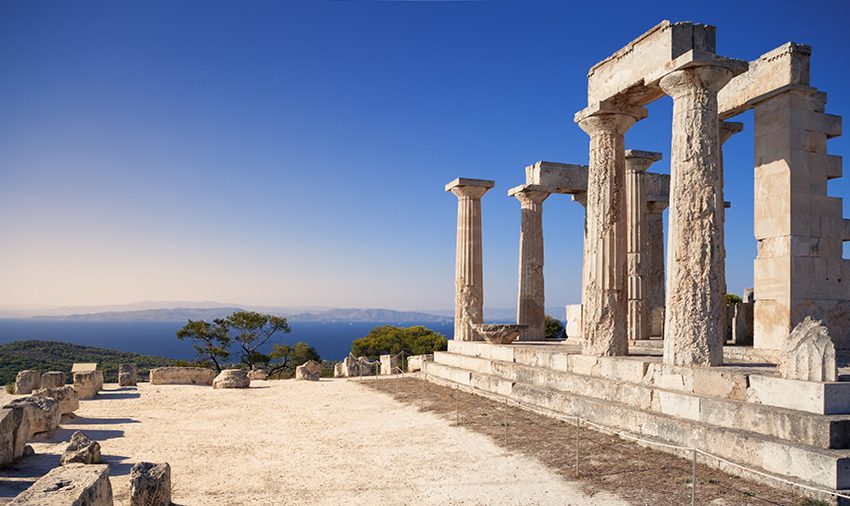About Aegina
Aegina, the capital city of the island, sits on its west side in an amphitheatrical arrangement facing the sea. Upon entering the harbor, you’re greeted by the small, white Saint Nikolas church.
Modern-classical buildings line the seafront in terrestrial shades, particularly stunning at sunset. The bustling economic and social hub is along the coastal road and parallel streets.
Don’t miss the fish market, traditional ouzo-serving restaurants, and fishing boats doubling as grocery stores. And be sure to grab Aegina’s famous peanuts.
Indulge in fresh fish and local cuisine at fish restaurants, or relax with coffee or a drink at harborside patisseries and alley cafes.
At night, enjoy dancing at the town’s clubs. Neoclassical buildings with folk elements hark back to Aegina’s stint as Greece’s capital in the 19th century for two years.
Aegina hosts history, art, and craft events, attracting Greek and foreign artists and writers for decades. The ground floors of many buildings house traditional coffee shops, restaurants, and more.
Colorful houses, vibrant flowers, and picturesque shops and taverns adorn Aegina’s narrow streets, charming visitors. The town of Aegina is beautiful, picturesque and it curiously evokes the visitor.
The Saint Dionisious cathedral yard hosts the Eunardio school. It was there, where the first greek government took place after the greek revolution in 1821. Metropolis street boasts the Aegina library and the Kapodistriako government House, formerly the first mint.
 In the outskirts of the town, there are archaic tombs, tombs of the parchment era, and the Byzantine church in the name of the Saints Theodoron, two kilometers west from the town. This church is a basilica of the 13th century.
One of the sights that we see when we visit Aegina is the Ancient city that was built in the neolithic years (3000 b.c.). And also the modern monuments that were created when the island was the capital of Greece for a short period of time.
Archaeological research has disclosed the presence of more than ten settlements starting from the early copper era (3000 b.c.). In the same area beside the remains and the pillar of the Apollon temple, there are also quite a few buildings and the foundations of two smaller temples, the temple of Artemis and the temple of Dionisos.
If you continue south you can see what is left from the memorial which was dedicated to Aiako, along with a big part of the Roman wall. Today on the hill of Kolona, there is the archeological museum of Aegina, in which many findings from the excavations are displayed there. Under the hill of Kolonas, you can still distinguish the remains of the piers of the famous “kruptou Limena” that was the warlike port in ancient Aegina.
Outside the port, there was a system with artificial reefs (a kind of marine minefield) which made it difficult and dangerous for the enemies to enter. The excavations affirm that there was a large theater and a stadium that were not preserved.
A typical picture of the town of Aegina, that every visitor can enjoy, is the hackney carriages which unceasingly go up and down the coastal road of the island carrying greek and foreign tourists. Near the port, on the left, as we get off the ship is an archaeological place called “Kolonas” known for its one and only pillar (kolona in greek), the only remaining thing from the temple of Apollo Delfiniou, built-in Doric order and it dominates on a hill. The hill of Kolonas was the Acropolis and the religious center of the ancient city.
In the outskirts of the town, there are archaic tombs, tombs of the parchment era, and the Byzantine church in the name of the Saints Theodoron, two kilometers west from the town. This church is a basilica of the 13th century.
One of the sights that we see when we visit Aegina is the Ancient city that was built in the neolithic years (3000 b.c.). And also the modern monuments that were created when the island was the capital of Greece for a short period of time.
Archaeological research has disclosed the presence of more than ten settlements starting from the early copper era (3000 b.c.). In the same area beside the remains and the pillar of the Apollon temple, there are also quite a few buildings and the foundations of two smaller temples, the temple of Artemis and the temple of Dionisos.
If you continue south you can see what is left from the memorial which was dedicated to Aiako, along with a big part of the Roman wall. Today on the hill of Kolona, there is the archeological museum of Aegina, in which many findings from the excavations are displayed there. Under the hill of Kolonas, you can still distinguish the remains of the piers of the famous “kruptou Limena” that was the warlike port in ancient Aegina.
Outside the port, there was a system with artificial reefs (a kind of marine minefield) which made it difficult and dangerous for the enemies to enter. The excavations affirm that there was a large theater and a stadium that were not preserved.
A typical picture of the town of Aegina, that every visitor can enjoy, is the hackney carriages which unceasingly go up and down the coastal road of the island carrying greek and foreign tourists. Near the port, on the left, as we get off the ship is an archaeological place called “Kolonas” known for its one and only pillar (kolona in greek), the only remaining thing from the temple of Apollo Delfiniou, built-in Doric order and it dominates on a hill. The hill of Kolonas was the Acropolis and the religious center of the ancient city. Geographical Info
Other Names: Aegina, Aigina
Longitude: 23o 25′ 59.99″ E – Latitude: 37o 44′ 59.99″ N
